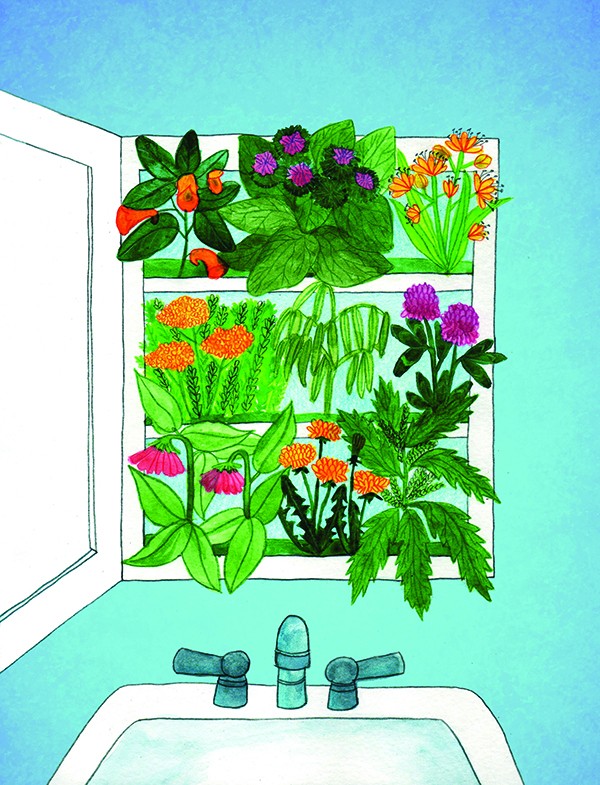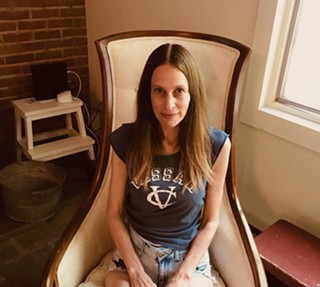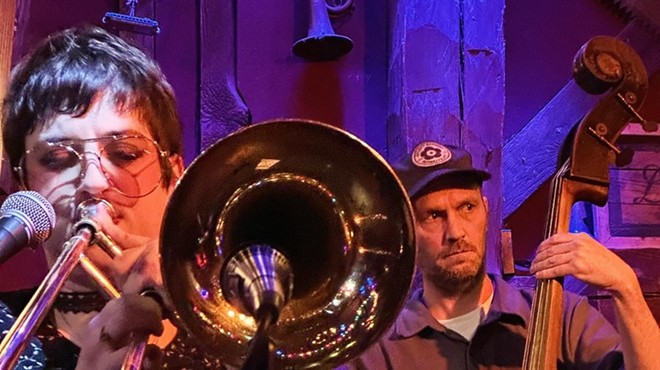On a family retreat to Costa Rica last month, Maia Toll didn't have her full collection of herbal remedies on hand, so she had to be creative. When a mysterious rash bloomed over her niece's face, she soothed it with mashed cucumber. A bashed toe got slathered with arnica homeopathic and "an everything-but-the-kitchen-sink salve" that her husband, Andrew, had picked up in Peru. A grease burn found relief with lavender essential oil. The oddest vacation complaint? A tickling in the ear that her brother-in-law developed after spearfishing in the ocean. Toll flushed his ear and watched in amazement as a tiny, cellophane-clear crustacean crawled out. It's fitting that, as an herbalist and educator who teaches others how to make DIY medicines, Toll would also become her family's de facto healer—a role she's come to embrace. At holidays and gatherings, she says, "The words after 'hello' are often 'Aunt Maia's here now. She'll have something for that.'"
Treating common complaints with common materials is an art and a skill that our ancestors possessed but that's largely lost today. In our culture of CVS convenience, it's all too easy to hand over our health to a brand-name label or Big Pharma script. People like Toll remind us that there's another way—a simpler, connected-to-the-earth way of taking charge of our own bodies. In her online course The Kitchen Witch's Workshop, Toll teaches the nuts and bolts of making your own herbal medicines, from syrups and tinctures to oils and balms. And it's easier than people think; making a tincture involves no more than putting your chosen herbs into a mason jar, filling it to the rim with vodka or cider vinegar, stirring, and sealing. "If you can find your way around the kitchen, you can make your own herbal medicines," says Toll, a former denizen of Beacon who now lives in Asheville, North Carolina, and teaches students from around the world. Yet despite how simple it is, "there's a lot of resistance, because we've been told it's not something we can really do. It's amazing to realize how conditioned we are to think that we can't take care of ourselves."
Red Clover Herbal Tincture from Maia Toll on Vimeo.
A Plant-Based Call to Action
Crafting our own "witchy" brews (to use Toll's reclaimed word) isn't the only alternative to mainstream medicine. Nowadays, we can choose from shelf-loads of herbal remedies at our local health food stores and apothecaries. But unbeknownst to many, these products might not always be there. Newly stringent FDA regulations, set in motion gradually over the past few years, are putting the squeeze on small herbal companies that make wild-crafted salves, tonics, tinctures, and body products. (One such company, Avena Botanicals, based in Rockport, Maine, is running a Kickstarter campaign to raise money to help them keep up with the latest FDA requirements.) It's worrisome that many of our favorite natural wellness and body-care products might become endangered before too long. But it's also a wakeup call that could launch more people on the path to making their own remedies and elixirs for wellness, beauty, and pleasure.
"If you start to take your health into your own hands and really ask questions, then you can see that there are a lot of answers in herbal medicine," says New Paltz-based herbalist Dina Falconi, author of Earthly Bodies & Heavenly Hair (Ceres Press, 1997) and Foraging & Feasting: A Field Guide and Wild Food Cookbook (Botanical Arts Press, 2013). "There's a lot of healing that can occur without having to jump over to pharmaceuticals yet—though when we need pharmaceuticals it's great to have them." Falconi teaches a six-month herbal intensive course that meets one Saturday a month from May to October on her six-and-a-half-acre property, amid a helter-skelter mix of wild and cultivated gardens. "True, 'normal' gardeners have heart attacks when they come here," she says of her landscape, where wild lettuce and other weeds—the medicinal powerhouses of the flora world—are given the space and encouragement to stretch out and thrive. Students in her course learn how to identify helpful botanicals, becoming plant literate as well as kitchen literate.
The intimate connection between food and medicine is a running theme for Falconi; in her clinical herbalism work, she always looks at a client's diet first. "Food is our primary source of healing," she says. "Once we've covered that base, there are so many wonderful herbs that can be part of the program. Nettles [which emerge in May] are a food medicine, and also dandelion, burdock, milky oat tops, oatstraw. Those are five really basic, common plants that have so much to offer. They have nutrient density, so they're really nourishing the body; they also have several chemical constituents or compounds that support liver function, kidney function, the nervous system." Falconi recommends not just making medicines and tonics, but also cooking with these herbs. "When nettles are out, you could be eating Swiss chard but you're using nettles instead—in your omelet, your quiche, your soup. What you're going to get is more magnesium, calcium, protein. It's powerful, nourishing food that's equal to medicine."
Loving the Whole Dandelion
To get the benefits of herbs in full force, many herbalists agree that it's essential to use the whole plant—not an extract, and not an herbal supplement in capsule form. "Food contains multiple nutrients that work together. A supplement contains one thing. It's like going to a symphony and just hearing the flutes," says herbalist Susun Weed, author of five books and leader of workshops and apprenticeships at her Wise Woman Center in Saugerties. Capsules, she warns, are ineffective, expensive, and potentially dangerous when manufactured incorrectly. (Indeed, the provenance of herbal capsules has recently come into question: In February of this year, the New York State attorney general's office tested store-brand supplements from chains like Walmart, Walgreens, Target, and GNC, and found that many of them didn't contain the active ingredients promised on the label.)
Authentic herbalism is a dirty business, and that's a good thing, says Weed. "Herbal medicine has a rainbow arc that goes from native people rolling in plants, literally absorbing their medicine, to white-coated lab technicians finding the active constituent of plants and replicating that in a laboratory to make a drug. That's all herbal medicine. What I'm trying to tell people is that you don't have to stay stuck with the lab technician, and you don't have to roll in the plants, either, though you would enjoy it," she laughs. "But you could take a few steps back—especially when you talk about preventive medicine and what I call daily care. It's the care of bumps, bruises, bites, stings, poison ivy, colds, flus, headaches, backaches, stomachaches. With preventive care, we're preventing type 2 diabetes, cardiovascular disease, osteoporosis, mood disorders. These things, to me, all lie firmly within the realm of people's medicine. People can learn how to do it with plants easily at their disposal, and they can do it themselves."
Talking to Weed, it quickly becomes clear she's on a mission to get everyone on Earth to drink nourishing herbal infusions—the simple-to-make, water-based drink that she champions over any other beverage. YouTube videos show Weed, like an herbalist Julia Child, demonstrating how to make infusions in about five minutes a day: placing an ounce of dried herbs (much more powerful than fresh, she says, and easy to find in health food stores) in a quart jar, filling with boiling water, sealing, and allowing to steep overnight. In the morning the herbs are strained out and the liquid is refrigerated and drunk throughout the day. Weed herself rotates through five herbal infusions: stinging nettle (for energy), oatstraw (for libido and heart health), red clover (for cancer prevention), linden flower (for anti-inflammatory and cold/flu support), and comfrey leaf (for healthy skin, muscles, and bones). Pleasant tasting and inexpensive, the infusions are an easy sell. They're a simple way to nourish and bring ourselves "back to our roots, to the Earth," says Weed—and in this case, with no gardening gloves required.
Your Body, Your Laboratory
With few clinical studies on the curative power of herbs, it's easy to dismiss them as a New Age belief system, and not true medicine. When wife-and-husband herbalists Aemen Bell and Luis Mojica take people on weed walks in their stomping grounds around Woodstock and Saugerties, "There's always someone in the group who will scoff, 'Oh, herbs don't do anything,'" says Bell. "And I say, haven't you ever had coffee? An herbal laxative? That's herbs doing something. The best proof is when they have a little poison ivy and they're trying not to [scratch] it, and I can get a fresh piece of jewelweed during the walk so they can rub it on—and in one minute, the itch is gone." (The pair is so enamored by jewelweed's anti-itch powers that they boil the herb and make ice cubes to keep in the freezer for a quick fix all year long.)
Like many herbalists, Bell and Mojica both discovered herbs when they got sick—and Western medicine couldn't do anything to help them. But herbs did. Moving to the Hudson Valley from New York City three years ago, they were drawn by the beauty and spirit of the Catskill Mountains, and a strong sense of place infuses the work that they do creating their Pinecone Apothecary line, which includes herbal tinctures, gem essences, and even herb-infused chocolates like their Burdock Bar (herbal truffles are coming soon). What's in their herbal medicine chest? Yarrow helps with colds, flus, stomachaches, and food poisoning ("You can drink little sips of it before you're able to keep other foods down," says Mojica). Burdock root "is a prebiotic, so it's good for your digestion and immunity," Mojica adds. "It makes your hair really shiny, is mineral rich, and grows everywhere." Putting burdock root in a jar with apple cider vinegar will slowly extract the medicine and make it more like food. "Then you can put it on your salad and have this great mineral-rich, burdock-infused salad dressing that lasts all year long."
How To Make Flower Essences from Maia Toll on Vimeo.
While matching herbs with their purported benefits can work as a baseline, the only way to really know how an herb will benefit your body is through personal, hands-on experience. In her online medicine-making class, Toll doesn't even tell her students which herb does what, because it might not do that in their bodies. "Valerian is a well-known herb for sleep, but for a small percentage of people it actually makes them hyper," she says. So instead of telling people about the curative properties of herbs, she teaches her students how to learn about the plants, and how to listen to their bodies and find what's right. For Toll, that's the difference between Western medicine and the earth wisdom of herbalism. "It's about paying attention to your body, what it says yes to, and what it says no to. Then you start to understand what makes you well—you feel it in your body. There's nothing more empowering than that."
RESOURCES
Aemen Bell and Luis Mojica Thepineconeapothecary.com
Dina Falconi Botanicalartspress.com
Maia Toll Maiatoll.com
Susun Weed Susunweed.com
Recipe for Marinated Dandelion Salad by Maia Toll.













